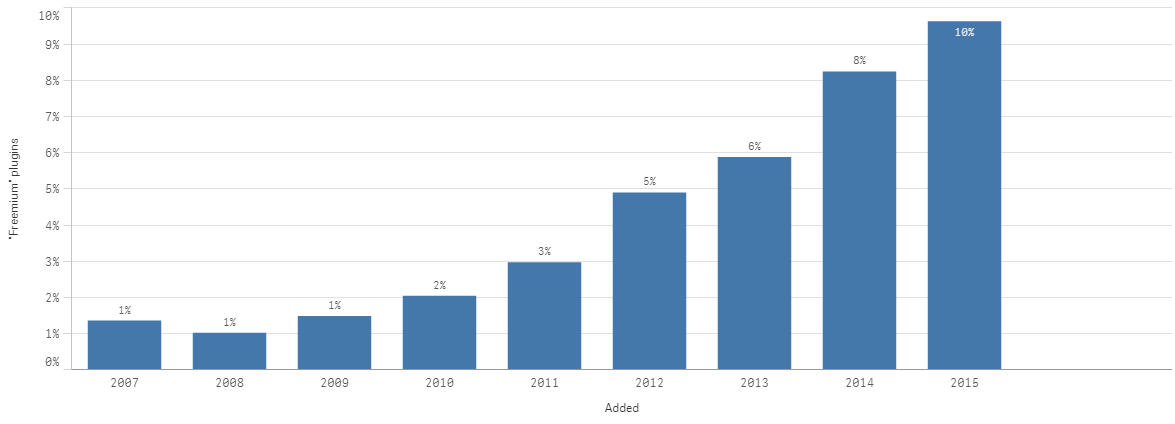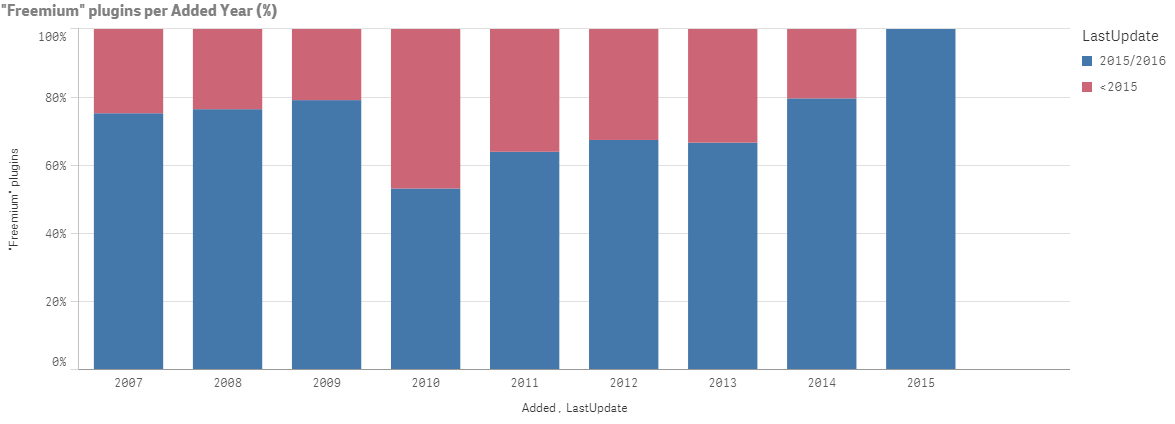|
|
Ever wondered if going freemium is the smart move for your plugin? Well, we’ve got some juicy data that might convince you.
First, let’s get our terms straight. When we say “freemium,” we’re talking about plugins with paid add-ons, premium versions, or services like premium support. We’ve done our homework, pulling data from the WordPress repository and crunching the numbers.
So, what’s the scoop? Freemium plugins have been on the rise for a decade now. In absolute numbers, we’ve seen more and more of them each year. Now, here’s the kicker — freemium plugins have a much better survival rate than free ones. It was clear even years back when freemium products were only starting to emerge: over 50-60% of freemium plugins were still being updated three years after the launch.

Compare that to the measly 10-20% survival rate for the average free plugin, and you’re looking at a 200% improvement!
And get this — this trend held steady no matter when the plugin was introduced. It seems that having a proper monetization strategy gives developers a real incentive to keep their plugins alive and kicking.

So, if you’re on the fence about monetizing your plugin, these numbers might give you the push you need toward creating sustainable, long-lasting plugins that continue to serve the WordPress community — and bring you income.
Let’s talk about how to recognize that it’s time to go freemium and how to make this transition smooth.
Signs It’s Time to Consider a Paid Version of Your Plugin
There are some telltale signs that might be nudging you in the direction of monetizing your WordPress product. So, let’s see what they are.
- Growing user base and demand: You know you’re onto something good when your plugin’s user base keeps growing. If you’re seeing a steady climb in active installs, it’s a great indicator that people find value in your work.
- Increasing support and maintenance costs: Remember when you could handle all the support tickets over your morning coffee? If those days are long gone, and you’re spending more time (and maybe money) on support and maintenance, it’s a sign you might need to monetize to sustain this level of service.
- Feature requests beyond the scope of a free plugin: Are users constantly asking for advanced features? If your inbox is flooded with requests for functionality that goes beyond your original vision, it might be time to create a premium version or add-ons.
- Market validation and positive feedback: When users are singing your praises and actively telling you they’d pay for more features, that’s market validation gold! It’s a clear sign that there’s monetary value in what you’re offering.
- Personal or team financial goals: Let’s be honest — we all have bills to pay. If you or your team have reached a point where you need to generate income from your development efforts, that’s a valid reason to consider monetization.
Actionable tip: Calculate your “plugin salary.” How much would you need to earn monthly from your plugin to make it a viable part-time or full-time gig? Use this as a goal for your monetization strategy.
Remember, transitioning to a paid model doesn’t mean abandoning your free users. Many successful plugins maintain a robust free version while offering premium features or support. The key is to find the right balance that serves your users and supports your goals.
So, if you’re nodding along to these points, it might be time to start planning your freemium strategy. Don’t worry, we’ll cover how to make that transition smooth and successful in the next sections. Stay tuned!
3 Ways to Go Freemium
Zooming out for a second to provide a brief overview of what it means to switch from free to freemium. You’ve got three primary options there:
- Introduce paid add-ons to the free product
- Launch a premium version of the product
- Offer premium complementary services
Paid Add-ons
This approach involves keeping your core plugin free while offering additional functionality through paid extensions. Here’s why it can work well for you:
- Low barrier to entry, as users can try your basic plugin for free
- Users pick and pay for only the features they need, so there’s a lot flexibility
- You can continually develop new add-ons to increase revenue
For example, WooCommerce follows this model, with numerous paid extensions for specific features.
Premium Version
This strategy involves offering a free version with basic features and a paid version with advanced capabilities. Benefits include:
- Users have a clear upgrade path and understand what they get by paying
- You can maintain two versions instead of multiple add-ons
- Free users are constantly exposed to premium features so it’s easier to upsell
Take Yoast SEO for an example. The plugin offers a free version and a feature-rich premium version.
Read more: The Ultimate Guide To Free Trials For Premium WordPress Plugins And Themes
Premium Services
This option keeps your plugin entirely free but offers paid services around it. Consider these advantages:
- Your plugin remains accessible to all
- You monetize your knowledge, not just code
- Direct interaction with paying customers
- You have multiple options to offer premium support, customization, or consulting
For instance, there are many free themes that offer paid customization services.
Each approach has its merits, and the best choice depends on your plugin’s nature, your target audience, and your long-term goals. Some developers even combine these strategies for maximum effect.
The key is to provide clear value in your paid offerings while maintaining a useful free version. Take a look at how Tobias Bäthge, founder of TablePress, approached this.
When he developed TablePress more than 15 years ago for his local baseball team in Magdeburg, Germany, Tobias had no idea that his free plugin would soon reach over 800,000 active installs.
In this video, Tobias shares his journey of successfully monetizing TablePress.
Assessing Your Plugin’s Monetization Potential
Alright, you’ve decided it might be time to monetize, and you’ve explored the ways to do it. But before you jump in, let’s take a good look at your plugin’s potential in the market.
It’s like checking the weather before going camping — a little prep goes a long way!
Analyzing User Demographics and Needs
Who’s using your plugin? Are they bloggers, small business owners, or enterprise-level companies? Understanding your user base is key to successful monetization.
To get this data, dive into your analytics. Use tools like Google Analytics (if integrated with your plugin’s website), the marketplace analytics (if you’re selling through a marketplace like Envato) or WordPress-specific tools like Freemius Insights to gather data on your users.
Look for patterns in:
- Geographic location
- Types of websites they run
- How they use your plugin
For example, if you find that 40% of your users are running e-commerce sites, you might consider developing premium features specifically for online stores.
Evaluating Competition and Market Gaps
Time for some competitive intelligence! What are other similar plugins offering? More importantly, what aren’t they offering?
A comparison spreadsheet will help you get a clear picture: list your top 5-10 competitors and their features. Look for gaps – these could be your golden tickets to monetization.
For instance, if you have a form plugin and notice that none of your competitors offer easy integration with a popular CRM, that could be your premium feature.
Identifying Your Unique Value Proposition
What makes your plugin special? Why do users choose you over the competition? This is your unique value proposition (UVP), and it’s crucial for monetization.
If you can’t quite pinpoint a single aspect of your product that you’d consider a UVP, ask your users! Send out a quick survey or email asking:
- What’s their favorite feature of your plugin?
- What problem does your plugin solve for them?
- Why did they choose your plugin over others?
Use this feedback to define your UVP. Maybe your plugin is the easiest to use, or perhaps it’s the fastest, or it might have a killer feature no one else offers.
For example, if users consistently praise your plugin’s user-friendly interface, your UVP might be “Complex functionality with drag-and-drop simplicity.”
Food for thought: Your monetization strategy should align with your UVP. If your strength is simplicity, don’t overcomplicate things with too many premium features. Instead, focus on making advanced functions just as easy to use as your free features.
Read more: Make Money Selling WordPress Themes & Plugins: A Free Cheat Sheet
Planning a Smooth Transition to a Freemium Strategy
Making a smooth transition to introducing paid features or versions to your WordPress product is crucial for maintaining user trust and loyalty. A well-executed transition minimizes user churn, encourages positive word-of-mouth, and helps avoid negative reviews that could harm your plugin’s reputation. You’ll also get an opportunity to gather valuable feedback, refine your offerings, and create a stable income stream.
If you choose to gradually introduce premium features, and potentially offer loyalty discounts, you can turn your free users into advocates for your paid version. This approach not only respects your existing user base but also sets the stage for long-term success. It will make users feel they’re getting an upgrade, not a bait-and-switch.
Deciding Which Features to Keep Free vs. Paid
This is the million-dollar question (hopefully literally!). You want to keep your free version valuable while making your paid version irresistible.
It’s a good idea to use the 80/20 rule. Aim to solve 80% of your users’ needs with the free version, and offer the “power user” features in the paid version.
For example, if you have an SEO plugin, keep basic on-page optimization free, but offer advanced features like content analysis or schema markup in the paid version.
Prefer visualizing your decision making? Create a feature matrix. List all your features and categorize them as “Essential,” “Power User,” and “Nice to Have.” This can help you decide what goes where.
Read more: How to Decide What Features in Your Plugin Should be Free or Premium
Pricing Models (One-Time vs. Subscription)
One-time payment or recurring subscription? Both have their pros and cons.
Consider your ongoing costs and development plans. If you’re constantly adding features and providing support, a subscription model might be best.
For instance:
- One-time: Great for plugins with minimal ongoing support needs, for example — a plugin that adds a specific function to WordPress, like a custom post type creator.
- Subscription: Ideal for plugins that need regular updates or offer ongoing value. For instance, a security plugin that needs constant updates to protect against new threats.
Tiered Pricing Structures
Not all users are created equal. Some want the basics, others want it all. Tiered pricing lets you cater to everyone. Create 3-4 tiers, including your free version. A common structure is:
- Free
- Pro (individual use)
- Business (small teams)
- Enterprise (large organizations)
For example, a form builder plugin might offer:
- Free: Basic forms
- Pro ($49/year): Advanced fields, basic integrations
- Business ($99/year): Team collaboration, more integrations
- Enterprise ($199/year): Custom development, priority support
Your freemium strategy isn’t set in stone. Maybe you’ll find users are willing to pay more than you thought, or perhaps a feature you thought would be premium is actually better as a free offering to attract more users.
The goal is to create a win-win situation: free users get a valuable tool, paid users get enhanced functionality, and you get a sustainable business model. It’s like baking a cake where everyone gets a slice, but paying customers get the extra frosting!
Subscribe and grab a free copy of our WordPress Plugin Business Book
Exactly how to create a prosperous WordPress plugin business in the subscription economy.

It’s Showtime: Launching Your Freemium Version
You’ve put in the hard work, and now it’s time to share your freemium masterpiece with the world. But the launch doesn’t come down to just clicking the “publish” button. Your success largely depends on how you treat your users during the launch — both existing and new.
Let’s elaborate what we mean here.
Your existing users are your VIPs — so that’s the kind of treatment they deserve. Clear, honest communication is key here.
Create a multi-channel communication plan. Use: in-plugin notifications, your email newsletter, blog posts, and social media updates to share your news with your audience.
For example: “Hey there! We’re excited to announce that SuperAwesome Plugin is leveling up! Check out our new premium features [link]. Don’t worry, everything you love about our free version isn’t going anywhere. In fact, we’ve added [new free feature] to say thanks for your support!”
Show your day-one fans some love! They’ve been with you from the start, so why not give them a sweet deal to incentivize purchase and reward loyalty?
You could offer a time-limited, exclusive discount for existing users.
Say you share something like this: “As a thank you for being an early supporter, we’re offering you 50% off our new Pro plan for life if you upgrade in the next 30 days. That’s our way of saying thanks for believing in us from the beginning!”
Now, after you’ve covered your existing user base, it’s time to spread the word and reel in those new pro users.
- Create comparison tables showing free vs. pro features
- Share case studies showcasing how pro features solve real problems
- Run a launch week special with a modest discount for new users
- Collaborate with WordPress influencers for reviews or webinars
For instance, partner with a popular WordPress YouTube channel for a “Top 10 Features in SuperAwesome Plugin Pro” video. Offer their viewers an exclusive discount code.
And another thing: leverage the WordPress repository. You can do the following to make sure your product shines there:
- Update your readme.txt file to highlight premium features
- Use eye-catching banners that promote your pro version
- Respond promptly to support requests, mentioning premium features when relevant
Bonus tip: Don’t neglect your free users post-launch. Keep improving the free version alongside the premium one. Happy free users can become your best advertisers!
Let’s sum it up
From recognizing the signs it’s time to monetize, to assessing your plugin’s potential, planning your strategy, and finally launching your freemium version – you’re now equipped with the knowledge to take your plugin to the next level.
The good news is that the WordPress ecosystem is flourishing, with more developers creating plugins with commercial capabilities, strengthening the community as a whole, so your upgraded product will surely find its loyal user base.
If you have questions on how you can reach a wider user base and manage the sales of your WordPress plugin effortlessly, message us on X or send us an email at [email protected].






![The Freemium Business Model In The WordPress Ecosystem [+Video] – A Tool For Increasing Sales?](https://freemius.com/blog/wp-content/uploads/2018/10/freemium-business-model-wordpress-featured-image.jpg)


Thanks for this well documented post, Luca! I think what we're seeing more and more now is market education in terms of price expectations when it comes to WordPress plugins.
If at the beginning everything "needed" to be free, it gradually moved to a "freemium" and as you mentioned sustainable model, which benefits both plugin authors and users in the long term.
Our first freemium plugin was Profile Builder, which allowed us to gradually transition from WordPress consulting to full time building and maintaining our plugins over at Cozmoslabs.
Hi Adrian, I agree that the perceived value provided by freemium/premium plugins is improving. I think the good part about this analysis is that we can put some numbers of something which is really important like the "life expectancy". I like free stuff as much as anybody else, but price is only one of the variable into the buying equation... :-)